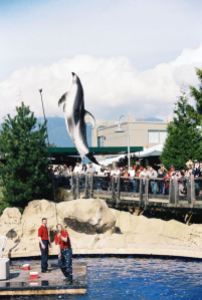(This post continues from the previous one. To read that entry first, click here.)
The Dolphin Training game shows us how much fun–and success–we can have when learning by positive reinforcement methods, yet so few teachers use the approach the game suggests in their own pedagogies.
I’m not yet sure myself what teaching improv–or any subject, for that matter–exclusively by the principles of positive reinforcement would look like. What happens to discipline? Don’t some learners respond more to a gruff, in-your-face approach? Isn’t it more efficient to go straight to what’s wrong? Remove the stones in the way, and the river will flow, won’t it? Should we be teaching our learners that everything’s a Pollyanna success where nobody can fail and everyone gets a gold star?
Such questions are fair and deserve good consideration, but this last one in particular seems an all-too-common resistance to positive reinforcement. As if choosing the method means you have to be wimpy or spineless. Like you can’t challenge or call your students to greatness. Or that you have to ignore the realities of our often-competitive (but not always competitive!) world. I don’t buy it. I think the pushback has more to do with our own laziness or fear of failure.
Focusing on the negative when teaching improv seems particularly curious, if not painfully ironic. That’s doubly true if you’re a troupe that plays the Dolphin Game as part of your repertoire. Stepping into the delight of that exercise and then teaching by traditional critique-and-correction strategies seems like using a jewel as a paperweight, neither recognizing its beauty or unleashing its power. One group I know intentionally avoids giving praise or recognizing successes after a show, believing instead that good improvisors don’t need that kind of ‘babying.’ “We should already know what’s good,” one instructor told me. “We don’t need to be reminded of what we’ve done well.”
Such an approach misses the chance for mutual renewal and camaraderie-building. Any beginning improvisor can cite the predominant ethos of the art: accept ideas in a scene and build from them, rather than blocking or tearing them down. Going through a show or a scene immediately after its conclusion to find what could have been better is no such “yes, and.” Even doing a ‘balanced’ set of pros and cons could qualify as a “yes, but”‘, depending on the tone of feedback and the ratio between cheers and jeers. Naming what worked takes what happened and uses it to create more. Especially in the immediate glow after a performance, reminiscing about specific successes fastens them further for future recall. It also builds confidence, even for the best players: often we can’t know the specific positive impact we’ve had on someone else’s experience until they actively let us know.
There are so many ways to apply positive reinforcement and improv principles to our own teaching itself. What exactly do we want? How do we celebrate what we want immediately when it happens? How do we get clear with our “click” so the affirmation stays informational rather than emotional–what matters is that the improviser achieved the behavior, not that he pleased us as a teacher. And, how do we *build on* what a player brings to a scene rather than cutting it down? How can we rely on our learners’ creativity for finding solutions to our challenge? How can we do it *together* as good troupe members do, teacher and learner relying on each other to make it work best? Even sticking a toe into these waters suggests intoxicating fields of possibility.
Of course, those same waters can also prove sobering. Positive reinforcement methods may actually require that we as teachers notice that some of our students don’t want to be in the classroom–and then we’d have to consider what that suggests about our subjects or, worse, about us as teachers. We’d have to notice the ways in which we’re actually unclear about what results we’re asking for. We’d have to see how we’re sloppy or undisciplined about properly timing our feedback. (I, for one, have a long way to go in prioritizing my grading and notes-giving so that it gets back to the kids quickly enough to have real meaning.) Part of me thinks we avoid the call of positive reinforcement because we hesitate to dig into the self-reflection and self-improvement it would demand.
All this said, I don’t want to throw any babies out with the clouded bath water. There may well be a helpful place for “notes” and other critical feedback. If I as a learner can come to see “failure” as an opportunity to grow rather than as a pronouncement of unworthiness, maybe such correction becomes a gift. If I as a teacher stay judicious and sparing in my critique, perhaps I can get to the point more quickly and help my students develop a mindset that forges their motivation even further. Skillful improvisors can transform any input.
At minimum, it seems especially clear that the critique should not come at or immediately following the vulnerable moment of performance. Let the learner integrate the success of her *effort* first. Note the need for improvement internally but shelve the desire to share it immediately. Hold the “Yes, but” and add another helping of “Yes, and.” Give a mackerel when the job’s well-done and return for another day of joyful learning. A chastised dolphin mostly learns to leave the tank.




Jane Lynch spoke at this year’s Smith Commencement about the “yes, and” principle, and also about the occasional need for “the awesome power of NO WAY” (http://youtu.be/RwuNfHSOxZI). She was, however, talking more about personal challenges than about communicating with others. I think the question of if and where critique fits in a positive, affirmative teaching model is a fascinating one, and I’m excited to see you have any further insights this year! Thoroughly enjoying the blog
I’ll look forward to checking out that video, Sarah. Thanks for the link. I agree that “No” has its place, and an important one. The timing and frrequency makes such a *huge* difference. (See “Shamu’s Golden Ratio” for more on that thought.)